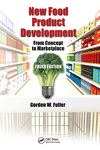It’s hard to believe that as recently as a couple generations ago, finding organic anything—let alone organic packaged snacks and baked goods—required a special trip to the “health food store” or local co-op (assuming your locality had such a place). Now, even big-box emporia dedicate shelves, if not entire aisles, to organic options—underscoring just how mainstream this one “fringe-y” sector has become.
Yet while organics may be mainstreaming, the hard work of formulating and producing to USDA’s National Organic Program remains … well, hard work. And the task can be especially arduous when the goal is creating the convenient, increasingly sophisticated snacks and baked goods that consumers—even organic ones—love.
Fortunately, says Don Trouba, director, go-to-market, Ciranda, Hudson, WI, “The organic snack and bakery landscape continues to evolve, and today’s consumers benefit from a market that’s maturing.” How does he know? The evidence is on display—literally: “The most visible sign is the increasing number of organic finished-product launches, and the increasing number of ingredients available organically.”
Valuable shoppers
Mainstream or not, the audience for organic foods is an ardent one that’s proven not only its loyalty to the category, but its willingness to back that loyalty with its grocery spend, as well.
As Sally Lyons Wyatt, executive vice president and practice leader, IRI, Chicago, points out, “Organic buyers are highly valuable shoppers across the store. In fact, heavy organic buyers represent 18% of US households and spend 34% more than the average household across the total store.”
Even better, she says, heavy organic buyers “tend to be affluent millennial families with children,” suggesting category support that could persist for generations
“Another interesting point,” adds Cate Batson Baril, marketing manager, Global Organics, Cambridge, MA: “Gen Z, millennials and younger Gen Xers are the biggest organic consumers out there.”
How big? IRI data indicates that they and other fans helped organic foods and beverages earn a total US multi-outlet-plus-C-store take (encompassing grocery, drug, mass market, convenience, military, and select club and dollar retailers) totaling $25 billion over the 52 weeks ending January 23, 2022, representing a dollar increase of 1%. As for organic snack and bakery specifically, IRI’s calculations show that both categories enjoyed sales increases of 6% during the same period.
Clean and clear
Those are powerful figures, and woe betides the brand that fails to capitalize on the demand underlying them. Or, as Jan Grinstead, team lead, strategic growth platforms, The Hershey Company, Hershey, PA, puts it, “Offering organic options has the ability to increase consumption and bring in new buyers—driving incremental growth for the category.”
Grinstead’s found that organic chocolate consumers “generally look to buy organic for themselves and their families, with their key drivers being taste and a sense of feeling good about the quality and type of ingredients included.”
And if those drivers look a lot like the ones fueling the clean-label movement, that’s because they are—and they’re as relevant to organic snacks and bakery as they are to organic chocolate.
For instance, “Brands are finding themselves in the hot seat explaining ‘processing agents’ and other additives that consumers don’t recognize,” Batson Baril points out. “Organic, with its stricter regulatory processes regarding allowable ingredients, gives parents an easier way to know that they’re buying good, safe products for their families.”
This is especially true in the snack space, she says, where “more parents are passing on products made with high-impact flavors, artificial coloring and highly processed ingredients for snacks that have an ingredient deck they can understand. Organic snacks and baked goods are a natural response.”
But clean labels alone aren’t all that compels organic’s most avid patrons. “Heavy buyers seek out products that align with multiple needs by choosing options that make more than one claim,” Lyons Wyatt says. “As an example, they may seek organic plus functional benefits, or dietary claims around vegan and vegetarian, dairy-free, animal welfare, and soy-free.”
Trouba agrees. “Clean-label centers largely on simplicity,” he notes, “demystifying foods by making them with understandable ingredients. And while this potentially suggests purity, organic takes it to another level entirely thanks to its halos of health, quality, and sustainability.”
Formulators are already petitioning suppliers for ingredients that check all these boxes. “I regularly hear from our brand customers that they need more information about ingredients,” says Paul Whitman, fruit and vegetable category manager at Global Organics, “and more depth of information.”
To deliver on those requests, Global Organics’ quality teams capture key data from their suppliers via life-cycle analyses that catalogue everything from an ingredient’s environmental footprint to the labor practices involved in its growth and harvest, Whitman says.
(sub) Sourcing sore points—and solutions
That’s not always easy to do, but “easy” has never been a hallmark of organic production.
“There are significant challenges around sourcing a regular supply of high-quality, certified-organic ingredients to support clean-label and organic claims,” says Tyronna Capers, director of marketing, Bunge Loders Croklaan, Chesterfield, MO. “With farmers still transitioning to organic, it can be difficult to secure raw materials that truly meet all the organic standards.”
Adding to those hurdles are the supply-chain disruptions now plaguing producers of everything—organic or otherwise. And this “logistics logjam” is particularly pernicious in its ability to delay ingredient imports, says Jim Mitchell, innovation and development lead at Ciranda.
“This puts a load on formulators to test alternative suppliers or even alternative ingredients just to produce products,” he says. “Yet formulators don’t always have the chance to run pilot tests to ensure a substitution works.” His solution: “Finding suppliers that’re conversant with the functionality and use of their products can help.”
And while the pool of organic farmers and suppliers has yet to match the size of its conventional counterpart, “With so much demand growth,” Batson Baril says, “brands can work with suppliers to mitigate supply issues. Sharing demand and production plans lets critical growth intelligence inform the entire supply chain—signaling to farmers to grow more, processors to know which formats are most in demand and importers and suppliers to stock ingredients in the right warehouses at the right time.”
Playing by the rules
Once that’s locked in, the task turns to using those ingredients in formulations. And as far as Jamie Mogilner, director of marketing and business development, Batory Foods, Rosemont, IL, is concerned, “The biggest challenges for organic formulators are still around regulations and the availability of functional ingredients.”
Per current USDA organic standards, a product can make an “organic” claim while still contain up to 5% nonorganic ingredients—assuming those ingredients aren’t commercially available in organic form, Mogliner says. “With the need for functional properties like preservation, stabilization, emulsification and more—as well as the limited access to organic options that deliver these properties—developing shelf-stable, high-quality snacks, and baked goods can be challenging,” she concedes.
But here again, suppliers are fast at work developing options, workaround and other strategies to get the job done. “As a global manufacturer,” Capers says, “you have to navigate—and apply—regional and national legislation. We can help customers navigate these ever-changing regulations to ensure their products meet organic standards.”
Take the case of a widely used functional input like lecithin. For its organic customers, Bunge Loders Croklaan can produce the base oil via pressing only, Capers says, “and only water-degumming is allowed—no chemicals.” While the added steps lengthen production and can complicate the supply chain, she says, they’re worth it if organic certification is a must.
Similarly, Bill Hanes, vice president of marketing and strategy, Lesaffre, notes that his company is doing what it can “to support bakers in achieving 100% organic certification, which requires the use of organic yeast.” How so? “We offer the only commercially available organic yeast made in the US,” he claims, “alongside a full portfolio or organic dough-conditioning systems that produce softness, volume, and dough relaxation.”
Big strides are being made in organic production, too. “Even in the recent past,” Batson Baril recalls, “it was rare to see fully dedicated organic facilities,” as wash-downs between conventional and organic production runs inflated manufacturing costs and production times alike.
“But as the organic sector has matured,” she continues, “more brands are producing completely within organic facilities and have sourcing teams that understand organic sourcing timetables.” What’s more, she says, “Professional manufacturing at the brand and co-packer level has greatly improved organic product quality and consistency.”
Evolving shelves
All of which should please organic consumers—as should the expanding variety of organic snacks and bakery items at stores. After all, says Batson Baril, “Today’s moms and dads have grown up with organic food; they expect to find organic products in more categories, especially where their young families are concerned.”
They also expect to find them in more varieties and flavor profiles. As such, Lyons Wyatt believes that a sure route to growth across organics drives right through flavor innovation. “We see different flavors spurring growth within different categories,” she says—“for example, fruit flavors are driving snacking growth, while herb and spice are winners in bakery. Asian profiles are even leaders within cookies and crackers.”
For his part, Whitman praises organic coconut sugar, milk and cream for providing “such good flavors with deep roots in sustainability.” Beyond that, he’s noticed interest novel fruit ingredients like organic wild blueberry purée, noting that “‘wild’ is nearly as strong a driver as organic.” Beyond that profile, “We’ve seen many R&D managers experiment with guava and passionfruit,” he says. “And fnally, I’m keen on ingredients like dried banana that could replace some or all of the sugar or eggs in formulations in the free-from category.”
Permissible indulgence
Replacing the negatives while bolstering the clean, sustainable positives reinforces organic’s core appeal. But, say industry insiders, snacks, and baked goods are still … snacks and baked goods. And that means they should still be fun.
That’s why Trouba sees the cakes, pastries, and sweet-goods as opportunities for innovation, “especially considering how organic ingredients can give consumers permission to indulge,” he says. “As the pandemic has lingered, more consumers look for enjoyment in life, and organic foods tap into this trend.”
That’s been Mogliner observation, as well. “Consumers still want indulgent treats, but they want them to be permissible ones,” she says. “Organic ingredients give consumers the better-for-you choices they crave, but without sacrificing gratification.”
Lyons Wyatt reminds organic brands to keep changing consumer demographics—and priorities—in mind, particularly as the young children of today’s millennial consumers grow up. “For example,” she says, “kid-focused brands should have a plan for ‘aging up’ products for their user base.”
Such long-term vision bespeaks real optimism about organic snack and bakery’s future. And why shouldn’t brands be optimistic? “While nothing is ever certain,” Trouba says, “it seems a good bet that organic foods will continue to grow, and that snack and baking companies should be exploring the space if they’re not there already.”










